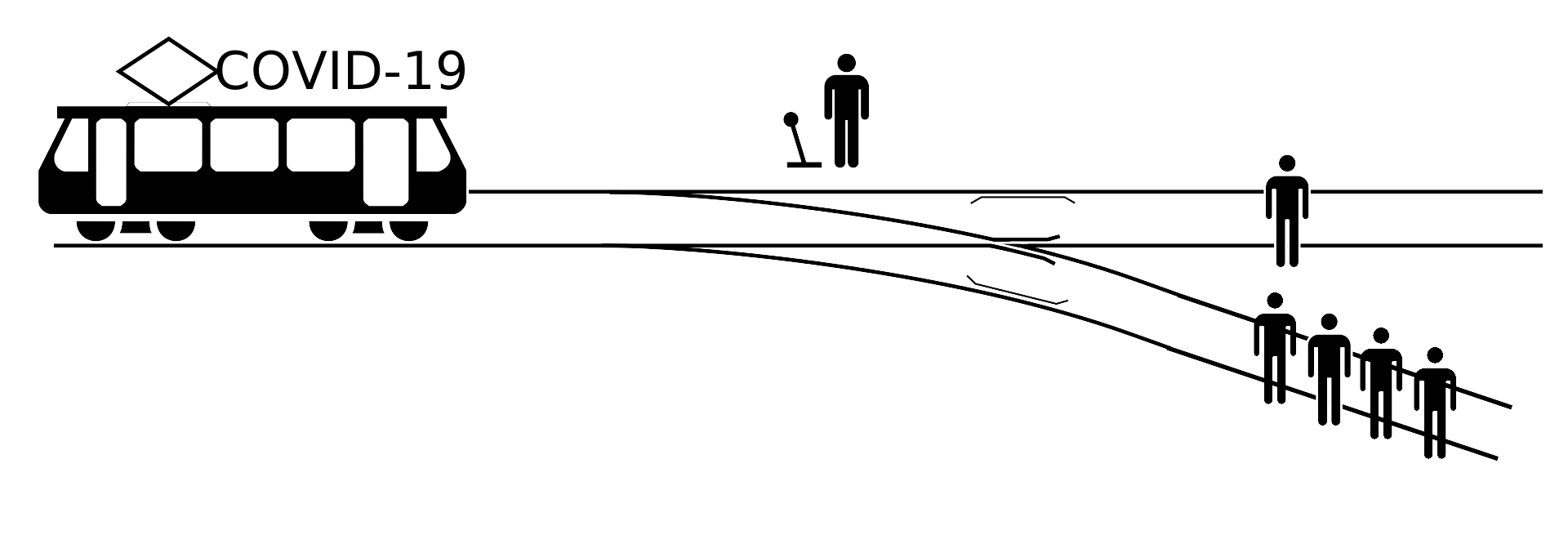Pandemic VIII: The European Trolley Problem
Published: 2021-04-04
Tagged: thoughts pandemic
My last pandemic-post stated:
"At a high level, they [bureaucracies] allow us to live longer, more meaningful lives. However, when they fail, their awesome power is turned against us."
It went on to describe bureaucrats doing silly things that decreased the vaccination rate. That's pretty bad when our measure of success is shots-in-arms per day. But were these failures a pattern common to all complex system–some steady rate of waste? Or was this a new pattern? I couldn't tell.
Then, a handful of EU countries decided to stop vaccinating people.
In broad brushstrokes, here's what happened: a group of researchers raised the alarm after a few people, all young and healthy, experienced serious problems with blood clots. The pros warned that this may be a side-effect of the vaccine. Government leaders faced a dilemma: keep going or stop the vaccination rollout.
The situation reminds me of a problem popular among ethicists called the "trolley problem." If you need a quick refresher, here's how it goes:
There is a runaway trolley barrelling down the railway tracks. Ahead, on the tracks, there are five people tied up and unable to move. The trolley is headed straight for them. You are standing some distance off in the train yard, next to a lever. If you pull this lever, the trolley will switch to a different set of tracks. However, you notice that there is one person on the side track. You have two options:
- Do nothing and allow the trolley to kill the five people on the main track.
- Pull the lever, diverting the trolley onto the side track where it will kill one person.
Which is the more ethical option? Or, more simply: What is the right thing to do?
Here's a graphical restatement of the above problem:
The COVID-trolley hurtles down the main track, straight at a stick figure that represents about 85 fatalities per week caused by blood clots. A lone figure–actually multiple EU leaders–stand ready by a lever that would send the trolley down a side track where four stick figures have been tied to the tracks. These four represent about 14000 COVID-related deaths per week. Should the EU-leader-figure pull the lever or leave it alone?
(Of course, these are back-of-napkin numbers. They don't factor in things like herd immunity, new strains, long-COVID, and other important details. However, I hope it's clear that 14000 is much larger than 85.)
Several EU member states pulled the lever.
Most people, when presented with the trolley problem, reply that they would sacrifice the one person to save the other four. So why did these government do the opposite?
Officials explained their decision with words like "caution", "responsibility", and "procedures." These are the sounds that a bureaucracy is expected to make in such a situation. It produces an aura of control and responsibility. I think it's meant to reassure people, even strengthen their trust in the fine men and women operating the bureaucratic machine.
Without this trust, without this faith, citizens would turn to other entities that could help keep them safe. They would decrease the flow of resources they send to the bureaucracy. They could even go as far as to question it and work around it.
In this case, choosing the lesser of two evils would make governments directly responsible for the 85 deaths per week. But allowing COVID to extinguish 14000 lives per week allows the machine to save face and say "We did the best we could, we followed all the procedures!"
Another possibility is that bureaucracies don't like changes. Adaption is expensive. It means reshuffling staffs, moving equipment, tons of paperwork, and lots of potential conflict between different departments. The optimal choice is to minimize change by letting existing structures handle the new challenge–even if it means huge inefficiency.
Finally, the most cynical interpretation says that bureaucracies pulled the lever because they have grown large and insulated from reality. This means that they simply cannot handle the present challenge any better. They're still emitting the right signals like speeches, regulations, guidelines, and official-looking documents. But in reality they're bumbling through this like a person performing CPR after having seen it in movies.
Whatever it is, it's clear to me that our institutions are running dangerously low of whatever magic fuel that powers them; that it's not business as usual; that we're seeing a new pattern, a new challenge that will require all the courage and ingenuity our species can muster.
Has it ever been any different?

Comments
Add new comment